Powdery mildew on gooseberries and currants: control measures, the best means and preparations for processing from spheroteca
A whitish mold has appeared on young shoots and leaves of currants, are gooseberry berries also all in a mealy bloom? If so, then, most likely, you are dealing with such a dangerous disease of currants and gooseberries as powdery mildew.
Next, you will learn how to get rid of powdery mildew on gooseberries and currants, than to process (which fungicidal preparations and agents are better to use) to protect the bushes and save the crop.
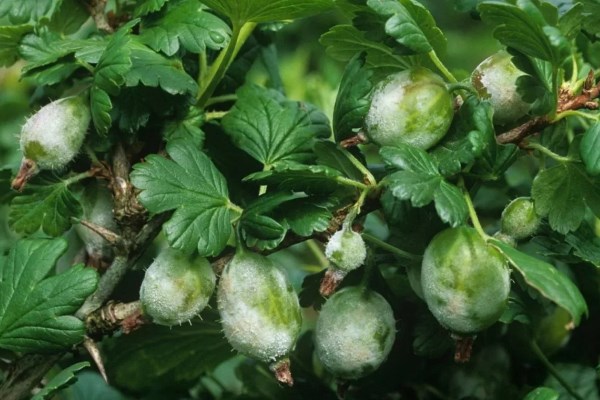
Content
What is American powdery mildew (spheroteka): a description of the disease, symptoms, causes
Powdery mildew, or spheroteca, is the most common disease of gooseberries and currants.
Why "American"?
Because this disease was brought from America along with planting material.
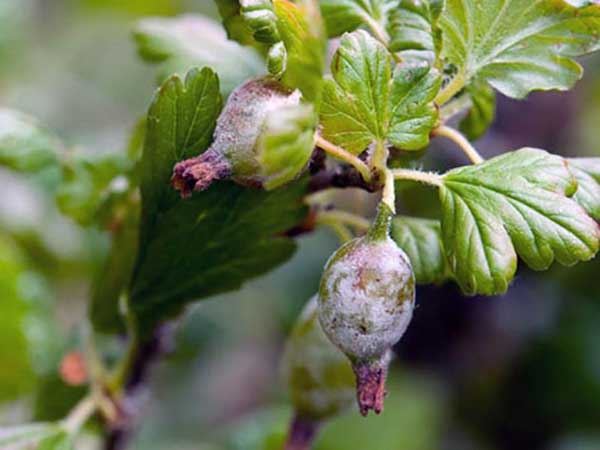
The disease is caused by a fungus Sphaerothecamors—uvaeBerk. Et Curt that amazes young leaves and shoots of currants, a on the gooseberry - more ovaries and berries.
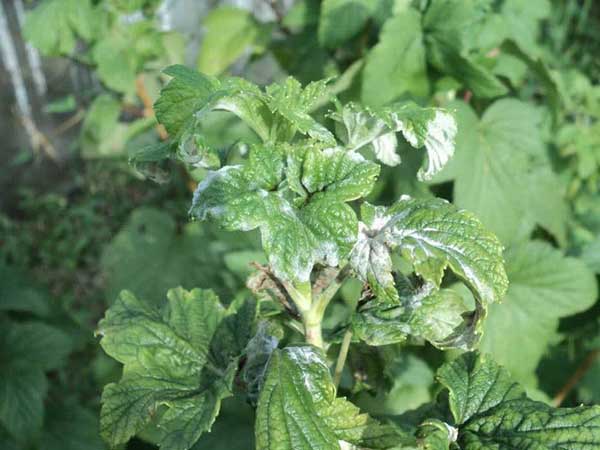
The pathogen hibernates on affected shoots and in plant debris (fallen leaves). And after wintering, with the onset of spring, (heat) is activated.
On the gooseberry the disease manifests itself almost immediately after the leaves bloom. All the affected parts of the bush are covered with a powdery bloom of white (this is the conidial sporulation of the fungus), while:
- young leaves curl;
- young (new) shoots stop growing and dry out;
- some ovaries may fall off, the remaining berries shrivel and dry out.
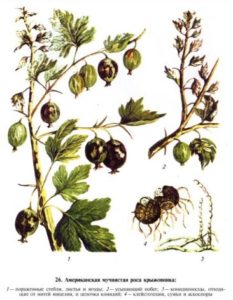
In the summer, the white bloom on the shoots and berries turns brown.
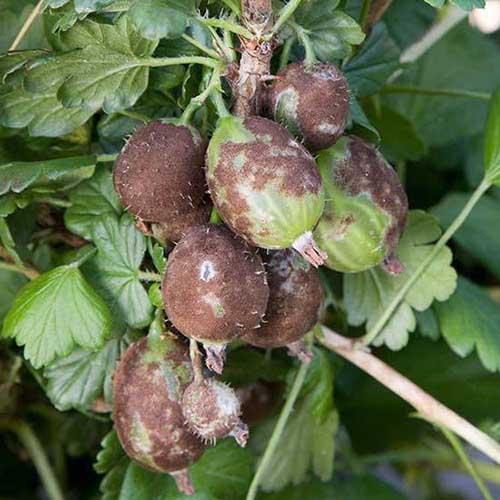
Currant powdery bloom also appears on new shoots and young apical leaves, which later curl up, and the shoots begin to dry out. Gradually, the white bloom turns brown again.
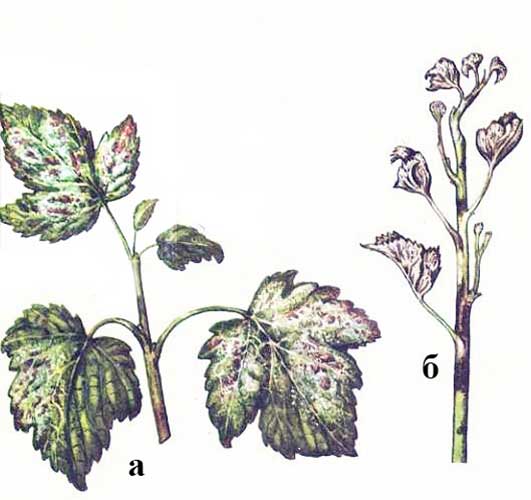
By the way! But currant berries, as a rule, are not damaged.
Wherein degree of defeat powdery mildew depends from weather conditions during the growing season. Thus, high air humidity (80-100%) and moderate temperatures (from +18 .. + 20 to +30 degrees) - these are the most favorable conditions for the active development and spread of powdery mildew.
Therefore, heavily thickened and poorly ventilated plantings are an excellent environment for the rapid spread of the disease (in rainy weather).
Agrotechnical measures to combat powdery mildew on gooseberries andcurrant
Here's what you can do to protect your bushes from powdery mildew (at least to keep them from spreading too much):
- Plant the bushes at a sufficient distance from each other.
- Prune regularly (early spring and post-harvest in fall).
In other words, try not to thicken the plantings!
Indeed, most often old and thickened bushes suffer from powdery mildew, so they should be periodically updated (carry out anti-aging pruning or multiply).
- Promptly cut off all affected and twisted shoot tops, and then burn or remove from the site.
- Destroy plant residues (fallen leaves).
- Initially, acquire and plant varieties that are resistant to the disease.
Russian, Kolobok, Eaglet, Northern captain, Vladil, African, Golden light, Komsomolsky, Muscat, Fertile, Northern grape.
By the way! Thornless varieties are generally more resistant to spheroteca than thorny ones.
- Do not get carried away with the typical nitrogen fertilizing, because of which the bushes begin to fatten (there is an excessive growth of the vegetative mass) and their immunity is weakened. On the contrary, it is worth giving more phosphorus-potassium fertilizers, which help to increase the plant's immunity.
When and how to properly treat the bushes from powdery mildew
Now let's talk about when (in what time frame) spraying should be carried out and how to do it most effectively.
Terms and scheme of treatments
So, as a rule, treatments against powdery mildew are carried out in the following phases of gooseberry (currant) development:
It is highly desirable to spend early spring eradication of the garden (before bud break), including sprinkling with currants and gooseberries.
- During the period buddingbut before flowering (“rose bud” phase).
As a rule, during this period, drugs based on copper or others continue to be used.chemical agents, but if the weather permits (above +10 .. + 15 degrees), then you can start using biological fungicides.
- After flowering, when pea-sized ovaries are formed.
- During the ripening period of berries (if necessary and depending on weather conditions), but before harvesting.
Thus, you need to carry out at least 3 treatments (every 7-14 days).
However! Even if it seems to you that you have already got rid of powdery mildew, 3 treatments are the minimum. Moreover, if you use biological or folk remedies.
Video: when to treat gooseberries from powdery mildew
rules
- Treatments should be carried out only in dry and calm weather.. In the morning or evening, or in the afternoon in cloudy weather.
In no case during the day, when it is sunny and as active as possible, otherwise such spraying can cause sunburn (only harm the plant).
- Preparations for processing, preferably periodically alternate (for example, use interchangeably) so that there is no addiction (resistance). In this case, it is important that the active substance changes, and not just the name of the drug.
- If after processingcontact drug it started raining immediately, then the next day spraying should be repeated. It's another matter if you use systemic drug, which penetrates into the plant and is not washed off with water.
- Chemical fungicides always have waiting period (after what time can you eat berries after processing), and this must be taken into account.
Important! Before using any drug (even biological), always carefully read the instructions for its use.
Preparations for powdery mildew on gooseberries and currants
There are many different fungicides on the market today for the treatment of gooseberries and currants. At the same time, it is not at all necessary to use only chemical agents, you can also do with biological products that are quite capable of protecting your crop, moreover, their use will not in any way affect its environmental friendliness.
There are also no less safe and effective folk remedies, the effectiveness of which, of course, is lower than that of special chemical and biological preparations, but as a prevention and fight against a minor lesion, they will do quite well.
Chemicals
Chemical preparations with fungicidal action, aimed at protecting and combating powdery mildew (active ingredients, nature and method of action of the drug are indicated in brackets):
- Copper based (copper sulfate): bordeaux liquid or simply copper sulfate.
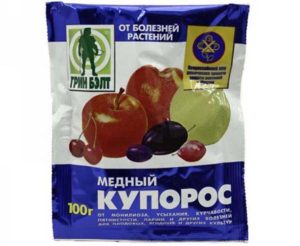
- Abiga-peak (Copper oxychloride, protective contact fungicide);
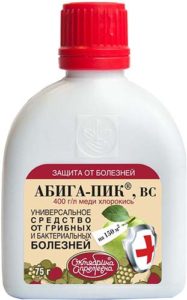
- Hom (copper oxychloride, contact protective fungicideactions);
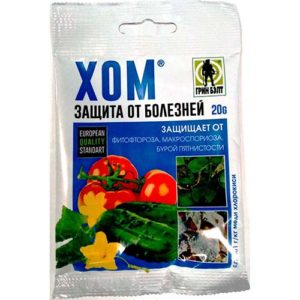
- Oxychom (Copper oxychloride and oxadixyl, contact-system fungicide protective action);
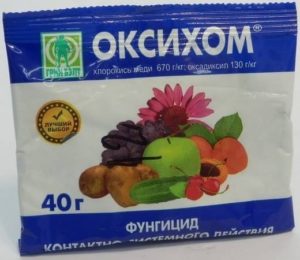
- Tiovit Jet (Sulfur, contact fungicide of protective action + acaricide + microelement);
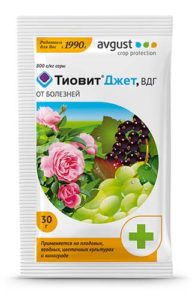
- Colloidal sulfur (Sulfur, contact fungicide of protective action + acaricide + microelement);
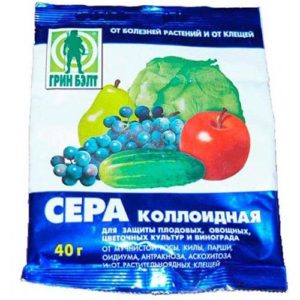
- Forecast (Propiconazole, systemic fungicide protective and healing action);
Spray during the growing season, before flowering and after harvest.
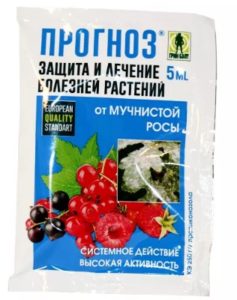
- Tilt (Propiconazole, systemic fungicide protective and healing action);
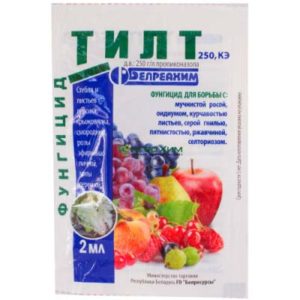
- Chistoflor (Propiconazole);
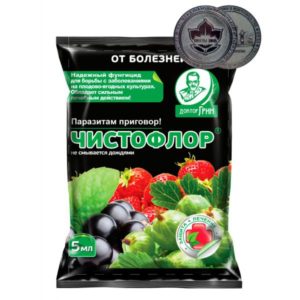
- Agrolekar (Propiconazole);
Note! The prognosis and Tilt, as well as Chistoflor and Agrolekar, are all analogous drugs that have the same active ingredient - Propiconazole.
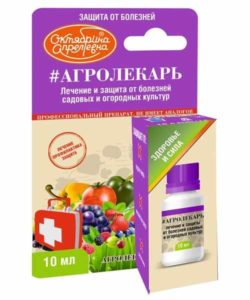
- Title 390 (Propiconazole, systemic fungicide of protective and curative action);
If in the preparations Prognoz, Tilt, Chistoflor and Agrolekar 250 g / l Propiconazole, then in Title deeds -390.
- Scor (Difenoconazole, systemic contact fungicide protective and healing action);
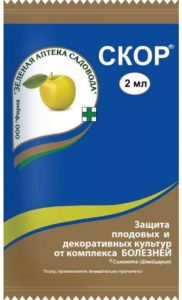
- Raek (Difenoconazole, systemic contact fungicide protective and healing action);
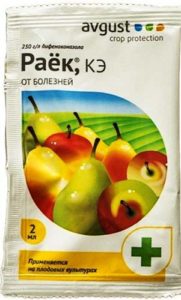
- Guardian (Difenoconazole);
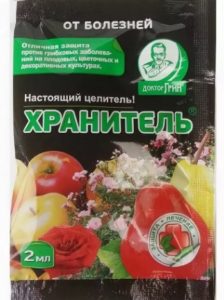
- Pure flower (Difenoconazole);
- Chistoflor (Difenoconazole);

Skor and Raek, as well as the Guardian, Chistotsvet and Chistoflor are also complete analogues, which have the same active ingredient - Difenoconazole.
- Topaz (Penconazole, systemic fungicide protective action).
Spraying during the growing season when the first signs of the disease appear.
Perhaps Topaz is the most popular chemical remedy for powdery mildew on currants and gooseberries.
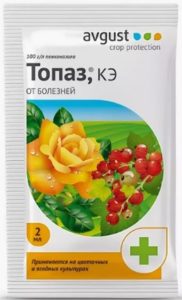
Biological agents
Biological products with fungicidal action against powdery mildew:
- Fitosporin (Bacillus subtilis strain 26 D, systemic fungicide of protective and curative action);
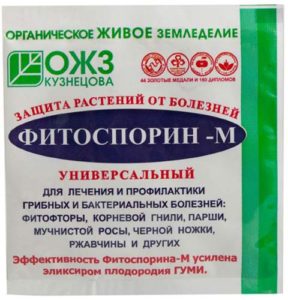
- Alirin-B (Bacillus subtilis strain B-10 VIZR, systemic contact fungicide of protective, immunizing and curative action);
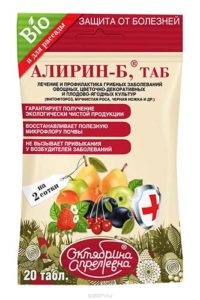
Spray during the growing season: before flowering, after flowering and at the beginning of berry formation.
- Gamair (Bacillus subtilis strain M-22 VIZR, systemic contact fungicide of protective, immunizing and curative action);
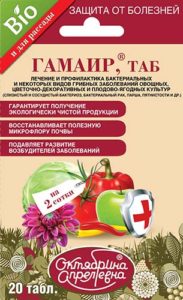
Pentafag, Mikosan, Ampelomycin and Gaupsin it is also sometimes used against powdery mildew.
Folk remedies
The most popular folk remedies for spraying gooseberries and currants for powdery mildew are:
- Iodine solution (1 ml per 1 liter of water).
Video: processing gooseberries with iodine from powdery mildew
- Infusion rotten hay... Fill a 10-liter bucket 1/3 with hay (about 3 kg), fill it with water, let it stand for 3-5 days, then dilute 1 to 3 with water.
- Infusion horsetail... 100 grams of dry horsetail in 5 liters of water, boil, let it brew for 12 hours, add 40-50 grams of laundry or green soap.
- Infusion fermented sour bread (1 kg of dry crusts per 10 liters of water, 1-2 tablespoons of sugar for better fermentation, let it brew for 3-5 days).
- Whey and sour milk.
Video: natural super-remedy for powdery mildew on currants (milk or curd whey)
- Infusion rotted manure or solution slurry (1 part manure 3 parts water).
- Broth or infusion wood ash ... Pour 400 grams of ash into 3 liters of water and boil for 3-5 minutes. Then bring the volume up to 10 liters or prepare the infusion - just fill it with hot water and let it stand for 24-48 hours. For better adhesion, you can add soap (40-50 grams of laundry or green soap per 10 liters).
By the way! Wood ash also works against caterpillars, sawflies and other pests (other than mites and aphids).
Video: combating diseases and pests of currants without chemistry using a solution of wood ash
- Soda solution (40-50 grams of soda ash per 10 liters of water + 40-50 grams of grated laundry or green soap can be added).
The essence of the application acidic (horsetail, whey) and alkaline (soda, wood ash) solutions in the fact that neutral acidity is most favorable for the fungus, while an increase or decrease in acidity should cause its death.
Well, now you know how to protect your berry bushes and fight the American powdery mildew.
By the way! The site has separate articles about when and process currants and gooseberries from other diseases and pests.

